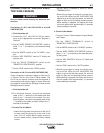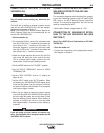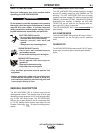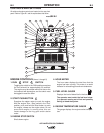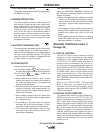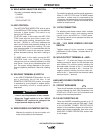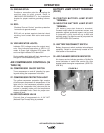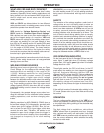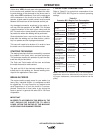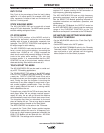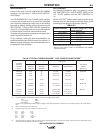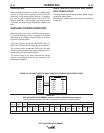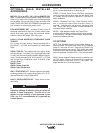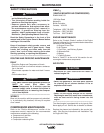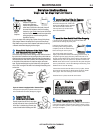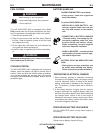
B-7
OPERATION
B-7
Unlike other VRD’s Lincoln uses micro processor con-
trol to monitor and establish the arc without the stick-
ing and shorting of the electrode to the job as seen in
many other VRD installations. Due to the requirement
of the resistance in the circuit to be low, for a VRD to
operate, a good metal-to-metal contact must be made
between the metal core of the electrode and the job.
Any damaged connection anywhere in the output cir-
cuit may limit the operation of the VRD. This includes
a good connection of the work return clamp and the
job. The work return clamp should be connected close
as practical to where the welding will be performed.
Some electrodes form a cone at the end of the elec-
trode after the welding arc has been broken, particu-
larly iron powder and low hydrogen electrodes.
This cone will need to be broken off in order to have
the metal core of the electrode to make contact.
STARTING TECHNIQUE
The starting technique that has successfully overcome
the problem is the push, twist, and peel technique.
This technique requires the operator to push the elec-
trode into the joint and twist.
The Push and Twist breaks off the cone and allows
the metal electrode to make contact.
The peel and lift of the electrode establishes a con-
trolled start to the welding arc. Normal welding tech-
nique for the application is then used.
BREAK-IN PERIOD
The engine used to supply power for your welder is a
heavy duty, industrial engine. It is designed and built
for rugged use. It is very normal for any engine to use
small quantities of oil until the break-in is accom-
plished. Check the oil level twice a day during the
break-in period. In general this takes 50 to 100 hours
of operation.
IMPORTANT
IN ORDER TO ACCOMPLISH THIS BREAK-IN, THE
UNIT SHOULD BE SUBJECTED TO HEAVY
LOADS, WITHIN THE RATING OF THE MACHINE.
AVOID LONG IDLE RUNNING PERIODS.
TYPICAL FUEL CONSUMPTION
Refer to Table B.1 for typical fuel consumption of the
AIR VANTAGE® 500 Engine for various operating
settings.
AIR VANTAGE® 500 CUMMINS
NOTE: This data is for reference only. Fuel consumption is
approximate and can be influenced by many factors, includ-
ing engine maintenance, environmental conditions and fuel
quality.
Table B.1
Cummins B3.3 Engine Fuel Consumption
Cummins B3.3 Running Time for
56HP(42Kw) 25GAL.(94.6L)
@1800 RPM (Hours)
Low Idle - .59 Gal./hour 42.4
no load 1425 RPM (2.2 L/hour)
High Idle - .87 Gal./hour 28.7
no load 1900 RPM (3.3 L/hour)
DC CC Weld 2.10 Gal./hour 11.9
Output 500 (7.9 L/hour)
Amps @ 40 Volts
Auxiliary Power 1.44 Gal./hour 17.4
12,000 VA (5.5 L/hour)
Air Compressor 1.29 Gal./hour 19.4
60 CFM @ 100 PSI (4.9 L/hour)
Air Compressor
60 CFM @ 100 PSI 2.46 Gal./hour 10.2
and DC, CC Weld (9.3 L/hour)
Output 500 Amps
@40 Volts
Air Compressor
60 CFM @ 100 PSI 1.94 Gal./hour 12.9
and Auxiliary Power (7.3 L/hour)
12,000 VA



